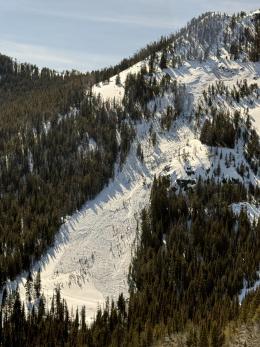Good morning. This is Doug Chabot with the Gallatin National Forest Avalanche Forecast on Wednesday, March 20th at 6:45 a.m. Today’s forecast is sponsored by Gallatin County Sheriff Search and Rescue. This forecast does not apply to operating ski areas.
Today will be mostly sunny with clouds rolling in this evening. At 5 a.m. temperatures are in the high 20’s F with W-SW wind at 10-20 mph. Wind will remain the same as mountain temperatures climb into the 40’s, just like yesterday. By predawn tomorrow morning there might be drizzle in the valleys and a skiff of snow at higher elevations. Winter will return by the weekend.
All Regions
Avalanche Accident near Mt. Blackmore
Two skiers were ascending a northeast-facing avalanche path on the northernmost ridgeline of Mount Blackmore around 1 p.m. when they triggered a large, dry slab avalanche that failed 3 feet deep, 150 feet wide, and ran 500 feet vertical. Debris piled up 4-8 feet deep. The avalanche failed on weak, faceted snow near the base of the snowpack. One skier was injured and rescued by Gallatin County Search and Rescue. Details and photos are here.
As evidenced by this accident yesterday and avalanche activity over the season (avalanche log), weak snow at the bottom of the snowpack is still a problem. Although the frequency at which avalanches are occurring is decreasing, the consequences of getting caught are not. Yesterday Ian and I went to Saddle Peak in the Bridger Range and found a poor snow structure which was similar to the rest of our forecast area: weak snow underlying the winter’s snowfall. The interface between the weak, sugary facets and slabby snow is noticed by digging with your shovel. The airy bottom layer can’t be missed.
Temperatures are going to warm and melt the snow surface, and at low elevations glop up the entire snowpack. Wet loose avalanches may travel long distances and could even trigger deep and big dry avalanches. Avalanches breaking deep are likely to be triggered 3 ways: from additional loading (snowfall or debris from wet, loose avalanches), from melt-water percolating down to the weak layer, or by triggering from a thinner spot, like the skiers near Mt. Blackmore did. My video from Saddle Peak shows this layer and discusses these points.
The danger will rise as the snow surface melts. Conditions will change rapidly, both temporally (in as little as 15 minutes) and spatially (soft skiing up high gives way to crashing through the wet snow lower on the slope). We have weak and unstable snow which is buried deep on many places. This depth makes it more difficult to trigger and more dangerous to be caught. Today, head home as the snow gets soft and punchy, and if you are on a shady aspect beware of hitting a thin spot that could trigger the entire slope. Dave’s recent video from Beehive Basin is instructive for wet snow avalanches.
The danger will start out as MODERATE and rise to CONSIDERABLE as the snow surface wets.
If you venture out, please fill an observation form. It does not need to be technical. Did you see any avalanches? How much snow is on the ground? Was the wind moving snow? Simple observations are incredibly valuable. You can also contact us via email (mtavalanche@gmail.com), phone (406-587-6984), or Instagram (#gnfacobs).
Upcoming Avalanche Education and Events
Our education calendar is full of awareness lectures and field courses. Check it out: Events and Education Calendar.
Loss in the Outdoors is a support group for those affected by loss and grief related to outdoor pursuits. Check out the link for more information.
The Colorado Avalanche Information Center, the Avalanche Research Program at Simon Fraser University and the U.S. National Science Foundation National Center for Atmospheric Research are conducting research to examine how backcountry recreationists, including skiers, mountain snowmobilers, snowshoers and ice climbers, interpret avalanche forecast information. They aim to better understand how useful different kinds of avalanche forecast information are for trip planning. To participate, take the Colorado Avalanche Information Center survey.


